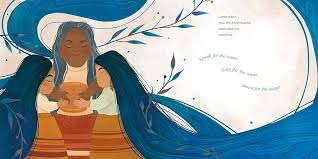"When daffodils start
popping up everywhere,
even in muddy ditches,
my sister tells me they're
the flower of Mother's
Day. We pick a bouquet
to give to Mom - after
rinsing off the dirt, of
course."
I read this from Jamie Oliver today: Tonight, the sun will set around 6pm and won't set before 6pm again until 29th Oct. I love just thinking he is absolutely right. It gives hope for the arrival of spring as days get longer, and sunnier!
This wonderful new book by Jack Wong is testament to that as well. The young child who narrates this homage to growing is on a neighborhood walk with his sister. As they go, smelling the flowers and checking out all they see around them, she teaches him about plants. They return home with some of the first daffodils of the season for their mother.
The world turns green. Now is the time for his sister to teach him about gardening, too. The weeds in her garden appear out of nowhere, covering her many vegetable seedlings. It is a lot of work for both to keep those weeds at bay. Together they work. As they do, she shares what she knows. Some of what he is learning has him wondering:
"I wonder why some plants are called
flowers, and others are called weeds.
And how some can be both, like goutweed,
which people used to call ground elder and
planted in flower beds on purpose."
How does his sister know so much about plants and gardening? How on earth will he ever know what she knows? When tiny white flowers emerge from the ground, he is surprised to learn she doesn't know what they are. She will have to do some research. The boy observes that they are both learning, and he gains confidence in trying some of his own gardening. It's reassuring to learn that everyone has something to learn.
As in previous books, Jack Wong's artwork impresses. His pastel images command attention for his use of light and shadow, perspective and its effects on the reader. It has a warmth that is both reassuring and impressive.

















































